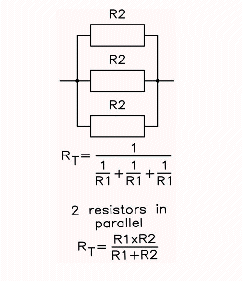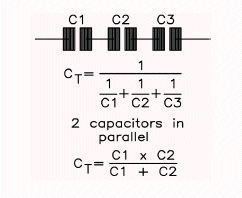|
|
|

Resistors in a parallel circuit are a
little more difficult. The formula to use is:


Capacitors behave exactly the opposite to
resistors: when capacitors are in parallel, you add them:


Capacitors in series, on the other hand,
are similar to resistors in parallel. You add the reciprocals:


Capacitors can pass alternating current
(AC) signals while blocking direct current (DC) signals. They can
also store electricity or act as filters to smooth out pulsating
signals. Very small capacitors are usually used in high-frequency
applications, such as radios, transmitters and oscillators. Very
large capacitors normally store electricity or act as filters.

The unit of capacitance (electricity
storage capacity) is expressed in farad, which is an extremely
large amount of electricity and too large a unit to use in
practice. Commonly used smaller units are the microfarad
(abbreviated µF), nanofarad (nF) and picofarad (pF). The section
on decimal multipliers shows the relationship between these. Some
capacitance values are commonly expressed by only one unit while
others can be expressed by two or more units, e.g. 1µF would
rarely be called 1000nF and never 1,000,000pF, even though these
are equivalent. However, 0.0047 µF is often expressed as 4.7nF, or
as 4700pF. If the value contains a decimal point the µ, n or p is
sometimes put in place of the decimal point. Therefore a 4.7pF
capacitor can be marked as 4p7F. farad |
|
![]()